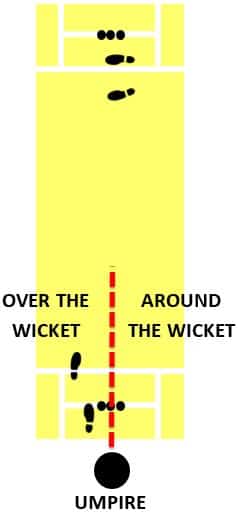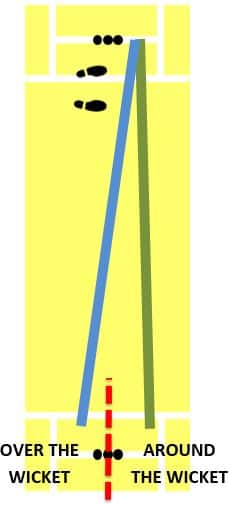Just before I was about to bowl my first ever ball in a cricket match, the umpire turned to me and said, ‘Are you bowling over or around the wicket?’. I stared back at him with a confused face, saying nothing. I felt so embarrassed that I didn’t know what either of these things meant, even though they’re so simple! That’s why I thought it would be a good idea to write this post! Hopefully it will clear up any uncertainty any of you may have about both of these terms, and help you to avoid pulling the confused face at the umpire.
The difference between ‘over the wicket’ and ‘around the wicket’ comes down to which side of the umpire the bowler delivers the ball from. A right arm bowler is bowling over the wicket if he/she delivers the ball from the left side of the umpire. If they deliver the ball from the right side of the umpire that is classed as around the wicket. The opposite is true for left handed bowlers.
A good way to remember it is that if a right arm bowler is bowling over the wicket, their right arm will be over the stumps. For left arm bowlers bowling over the wicket, their left arm will be over the stumps.
I’ve also mocked up a little diagram that you can see below, hopefully this will help to explain what I have written above!

The majority of balls bowled in cricket are from over the wicket. When a right arm bowler is bowling to a right handed batsman, or a left arm bowler is bowling to a left handed batsman, you will very rarely see the bowler choose to bowl from around the wicket! The majority of around the wicket deliveries occur when right arm bowlers are bowling to left handed batsmen, or left arm bowlers are bowling to right handed batsmen!
Why Do Bowlers Choose To Bowl Around The Wicket?
I guess a lot of you will be wondering ‘what’s the point in bowling around the wicket? What advantages will it give me as a bowler?’. Both of those are perfectly valid questions! There are a few main reasons why bowlers choose to change their angle of attack in this way, let’s explore a few of them…
To Test The Batsman’s Technique With A New Angle Of Delivery
This is the number one reason. Changing from over to around the wicket allows you to dramatically adjust the angle at which the ball travels towards the batsman.
Imagine a left-handed batsman who has faced over after over of a right arm fast bowler bowling over the wicket. Due to all the balls they have faced, the batsman will probably have adjusted to the angle and line of the deliveries. They will know which ones they can play and which ones they can leave and will have gotten into a good rhythm of doing it. Now, by changing from over to around the wicket, the bowler can disrupt that rhythm! All of a sudden, the ball is attacking them from a different angle. In this scenario, the right arm fast bowler can attack the stumps much more freely, as there is less risk that the batsman can just whip the ball off their pads in to the leg side. The bowler can now angle their deliveries into the body of the left-handed batsman, and then look to move it away slightly and find the outside edge. With the previous angle, the bowler will probably have been looking to push the ball across the body of the batsman, rarely attacking the stumps directly. The diagram below illustrates the difference between the angles that are created when a bowler shifts from one side of the wicket to the other! It really is a great way to throw off a batsman’s judgement on the line of deliveries!

One of the best examples of this I can remember was Andrew Flintoff bowling to Adam Gilchrist in the 2005 Ashes series. Flintoff saw a weakness in Gilchrist’s game so he decided to bowl the majority of his deliveries to him from around the wicket. This simple change caused Gilchrist so many problems! This was primarily because of the way Flintoff would get the ball angling in towards his body, before making it dart away by hitting the seam. He was also able to reverse swing the ball in both directions on an off-stump line!
To Target Rough Areas Of The Pitch
Certain spin bowlers may choose to bowl around the wicket because it allows them to land the ball in rough parts of the pitch that are caused by other bowlers’ footmarks. Footmarks on the pitch present a huge opportunity for spinners, as the ball will spin a lot more and behave differently if it lands in them. This leads to a lot of uncertainty for the batsmen!
Imagine a right arm leg break bowler (click here if you aren’t sure what a leg break bowler is) bowling to a left handed batsman. Now, let’s also imagine there are a lot of foot marks wide of the batsman’s off-stump. The bowler may choose to come around the wicket in this scenario as it will allow them to spin the ball back in towards the batsman’s pads with much greater regularity. If the bowler was to target the same foot marks whilst bowling over the wicket, the spin would still probably not be enough to bring the ball back in towards the batsman due to the angle of the delivery from that side of the wicket!

To Bowl To Specific Field Placings
Some bowlers will choose to come around the wicket because of the field that has been set for them by their captain. This can be a defensive move or an attacking move on behalf of the bowler! For example, a right arm leg break bowler may choose to bowl around the wicket to a right handed batsman if they have a heavy leg side field set. They will aim to pitch the ball outside the batsman’s leg stump and have the ball turn towards their body. I remember the Aussies trying this exact tactic on Kevin Pietersen to try and keep him quiet in one of the Ashes series!
For a more attacking example, some right arm fast bowlers choose to go around the wicket to right handed batsmen in order to bowl short at them. The captain will have a fielder close in on the leg side hoping that the batsman will knock one up in the air, as well as a couple of fielders out on the boundary in case the batsman plays the hook/pull shot. This change in angle of the short ball can lead to the batsman feeling quite cramped, and not feeling as if they can get away from the ball easily. When paired with the right field placings this can be a very dangerous bowling method!
Conclusion
I hope this post gave you a better idea of the difference between over and around the wicket, and the reasons why bowlers may choose to use each method!
Remember: You should always let the umpire know beforehand if you are going to switch the side of the wicket that you’re bowling from. If you don’t do this and just run up to bowl instead, the umpire is likely to call a no ball against you!
Also, if you’re an inexperienced bowler who is just starting to practice regularly, I’d recommend working on your bowling from over the wicket first! As I’ve already said, this is the much more common side of the wicket to bowl from so you need to make sure you get it as perfect as possible. Once you feel like you have a good level of accuracy when bowling over the wicket you can move on and work on your deliveries from around the wicket!
